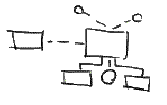Objective
1: Creating Artefacts.
In
the vision of the ‘disappearing computer’, information
artefacts are future forms of everyday objects that represent a
merging of current everyday objects (tools, appliances, clothing,
etc) with the capabilities of information processing and exchange
(based on sensors, actuators, processors, mircosystems, etc).
These artefacts have the capability of communicating with other
artefacts based on local (typically wireless) networks, as well
as accessing or exchanging information at a distance via global
networks. In this way, these artefacts posses the capability of
both local and global inter-working.
Individually,
artefacts may have a small range of capabilities but together can
exhibit a much broader range of behaviours. Alternatively, in certain
cases, they may be designed to individually have a wider range of
functions, but still working within an ensemble.
This
objective focuses on how to create individual artefacts, particularly
ones that will have the attributes of openness and connectivity,
so that together they can form an open and adaptable system. How
they can work together using this as a basis, is taken up in objective
2.
 New
Architectures New
Architectures
The
creation of artefacts requires research on new software and hardware
architectures, particularly ones that:
- Accommodate
trade-offs between networking, computing, and power consumption.
- Form
part of an open system that allows for wireless communication
with other artefacts, for example to connect with global networks.
- Allow
for adaptive behaviour, for example through the design of adaptive
software architectures, or re-configurable hardware.
- Allow
for an awareness of their context, for example with a system of
sensors.
- Enable
an artefact to be modular, either from the software or hardware
points of view.
Embedding
into Everyday Objects
In
order to make information artefacts, the IT components have to fit
them unobtrusively. This
requires research into ways of merging information technology with
objects and materials ,
including for example: ,
including for example:
- Methods
and techniques for adding-on or embedding IT components.
- Techniques
for miniaturising components so as to allow easy embedding.
- Coating,
or sticking components onto objects, or interweaving them with
their constituent materials.
- Research
could also consider approaches that would make it easy for people
to embed IT components into everyday objects themselves, for example,
with ‘do-it-yourself’ toolkits.
|